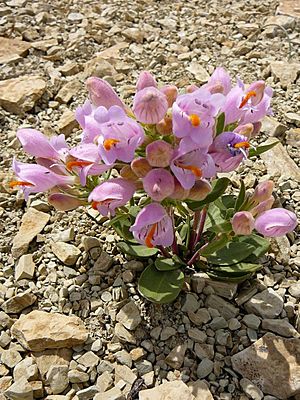Uinta Basin beardtongue facts for kids
Quick facts for kids Uinta Basin beardtongue |
|
|---|---|
 |
|
| Conservation status | |
| Scientific classification | |
| Genus: |
Penstemon
|
| Species: |
grahamii
|
The Penstemon grahamii, also known as the Uinta Basin beardtongue or Graham's beardtongue, is a type of flowering plant. It belongs to the plantain family. This plant grows naturally in parts of Utah and Colorado in the United States.
Contents
About the Uinta Basin Beardtongue
This plant is a perennial, meaning it lives for many years. It grows one or more stems that can reach about 20 centimeters (about 8 inches) tall. Its stems are a bit hairy. The part where the flowers grow has tiny sticky glands.
What Does It Look Like?
The leaves of the Uinta Basin beardtongue are thick and feel like leather. They are dark green or grayish in color. The leaves at the bottom of the plant are narrow. The leaves higher up wrap around the stem.
The flowers are shaped like tubes. They are usually between 3 and 4 centimeters (about 1.2 to 1.6 inches) long. Their color can be pink or lavender. Inside the flower's throat, there are reddish lines that guide insects to the nectar. A yellow, fuzzy part called a staminode sticks out from the flower's opening. This plant usually blooms in May and June.
Where Does It Live?
This special plant only grows in certain places. It likes rocky soil that comes from a type of rock called oil shale. This soil is found in northeastern Utah and a nearby area in Rio Blanco County, Colorado. You can find it growing in desert areas with shrubs. It also lives in pinyon-juniper forests.
Protecting This Plant
The areas where the Uinta Basin beardtongue grows are important. They contain oil shale, which is a rock that can be used to get petroleum. Petroleum is a valuable energy source. Because of this, there was a concern that exploring for petroleum might harm the plant.
In 2006, a group called the United States Fish and Wildlife Service (USFWS) thought about listing the plant as "threatened." This would give it special protection. They asked for information from scientists and another group called the Bureau of Land Management (BLM). The BLM manages much of the land where the plant lives.
After looking at the information, the USFWS decided not to list the plant as threatened at that time. Another group, the Union of Concerned Scientists, later said that the plant still needed more protection. They believed the plant did not have all the help it needed based on scientific facts.


